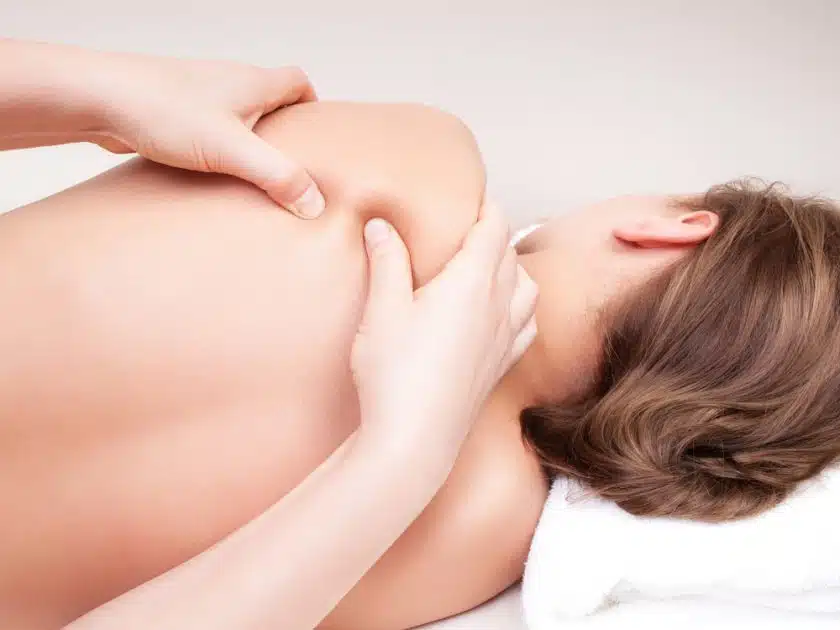What Is Swedish Massage? How Does Deep Tissue Compare?

Understanding the Techniques, Benefits, and Differences between Swedish Massage and Deep Tissue Massage
25th Apr, 2023
Since ancient times, people have used massage therapy, a common form of bodywork, to relieve stress, promote relaxation, and ease muscular tension.
Swedish massage forms the foundation for deep tissue massage techniques. While these two styles vary, they do have a lot in common. The key distinction lies in the pressure levels the therapist uses.
Swedish massage is a mild, calming style of massage that combines long, flowing strokes, kneading, and circular movements to release muscular tension and encourage relaxation.

On the other hand, deep tissue massage is a more intense form of massage that targets the deeper layers of muscle and connective tissue to release chronic tension and pain.
In this blog, we will explore the differences between Swedish massage and deep tissue massage, including their techniques, benefits, and what to expect during a session.
This article will assist you in selecting the best kind of massage for your requirements and interests, whether you are a massage aficionado or a first-time customer.
What is Swedish Massage?
Swedish massage is a gentle, full-body massage that uses long, smooth strokes, kneading, and circular movements on the topmost layers of muscles. The primary goal of Swedish massage is to relax the entire body and increase circulation.
It is one of the most often used massage methods and an excellent option for customers who have never had a massage before or who want a softer touch.
This technique provides a calming experience, but may not apply enough pressure for some individuals. Swedish massage is ideal for those seeking to feel revitalized and refreshed.
Swedish massage not only stimulates the nervous system but also benefits your skin, calms the nerves, and helps reduce physical and emotional tension in the body.

Here’s what you need to know about this massage technique: Swedish massage was first developed in 1868 by a Swedish doctor named Per Henrik Ling. Ling was interested in the healing benefits of massage and created a series of techniques that would become the foundation of Swedish massage.
Swedish massage techniques include long strokes, kneading, and circular movements, all designed to promote relaxation and improve circulation. The massage therapist may use their hands, fingers, forearms, or elbows to apply pressure and perform the various techniques.
Here are some of the benefits of Swedish massage:
- Swedish massage promotes relaxation and reduces stress and anxiety
- Gentle techniques are used to alleviate muscle tension and improve circulation
- Improved circulation can lead to an improvement in overall health
- The range of motion can be improved
- Pain and inflammation can be reduced
- Immune function may be improved
- The massage can be customized to individual needs
- Communicating with the massage therapist about specific areas of tension or discomfort is important.
Overall, Swedish massage is a gentle yet effective massage technique that can promote relaxation and improve overall health. If you’re looking for a soothing massage experience, Swedish massage may be the right choice for you.
What is a Deep Tissue Massage?
Looking for a more intense and revitalizing massage? Deep tissue massage is a good choice for those seeking deeper muscle pressure. This type of massage targets inner muscle layers, promoting healing by easing tension in muscles and tissues.
In deep tissue massage, therapists use stronger strokes to release tension in deep muscle layers and connective tissues. This type of massage may not be relaxing for everyone, as it involves firm pressure.
While deep tissue massage can be uncomfortable and is not ideal for stress relief, it does increase blood flow, reduce inflammation, and help with tension, soreness, and muscle knots.
Techniques Used in Deep Tissue Massage
Deep tissue massage uses a variety of techniques to target specific areas of tension and release tight muscles.
The primary Deep Tissue Massage methods are listed below:

- Slow, deep pressure – Unlike Swedish massage, which uses lighter pressure, deep tissue massage applies slow, deep pressure to the muscles. This pressure can be uncomfortable at times, but it is necessary to release tension and alleviate chronic pain.
- Friction – Deep tissue massage may also involve friction, which involves rubbing the muscles in a circular motion to release knots and adhesions.
- Finger Strokes – The massage therapist may use their fingers to apply pressure to specific areas of the body. This technique is often used to target trigger points, which are small, tender areas in the muscles that can cause pain.
- Stripping – Stripping involves using the fingertips or knuckles to apply pressure along the length of a muscle. This technique can be used to release tension in the muscles and improve flexibility.
- Stretching – The massage therapist may also use stretching techniques to improve the range of motion and flexibility. These stretches can be performed passively, with the massage therapist moving the client’s limbs, or actively, with the client participating in the stretch.
Deep tissue massage uses a variety of techniques to release tension and alleviate chronic pain. These techniques include slow, deep pressure, friction, finger strokes, stripping, and stretching. By targeting specific areas of tension, deep tissue massage can help to improve flexibility, range of motion, and overall wellness.
Benefits of Deep Tissue Massage, Including Relief of Chronic Pain and Improved Posture
Deep tissue massage is a massage technique that involves slow, deep pressure and targeted finger strokes, aimed at relieving chronic pain and tension. Here are some of the key benefits of deep tissue massage:
Relief of Chronic Pain
Deep-tissue massage is one of the most efficient massage techniques for reducing chronic pain, according to a survey done by the American Massage Therapy Association (AMTA).
In addition, research that appeared in the Annals of Internal Medicine indicated that deep-tissue massage was superior to traditional medical approaches like medicine or physical therapy for treating chronic pain.
Improved Posture
Poor posture can be a result of ongoing muscular stress and stiffness, which can also create a number of other health issues. The National Institute of Neurological Disorders and Stroke states that bad posture can cause headaches, breathing issues, and persistent neck and back discomfort.
Deep tissue massage can help to improve posture by releasing tension from tight muscles, allowing you to stand taller and straighter, with improved overall posture.
Reduced Stress
Stress is a significant health concern since it can lead to a variety of physical and mental health conditions. Chronic pain and tension can be significant sources of stress, both physically and mentally.
Deep tissue massage can help to reduce stress by promoting relaxation and reducing tension from tight muscles. According to research in the Journal of Alternative and Complementary Medicine, deep tissue massage averaged a 31% reduction in cortisol levels, the hormone linked to stress.
Improved Athletic Performance
As a result of the intense and repeated nature of their games, athletes frequently suffer from discomfort and injury. Athletes can benefit particularly from deep tissue massage since it can assist to improve general flexibility, enhance range of motion, and reduce discomfort and inflammation.
The deep-tissue massage was shown to be beneficial in lowering muscular soreness and enhancing the range of motion in athletes in a research published in the International Journal of Sports Physical Therapy.
Improved Sleep
Chronic pain and tension can make it difficult to get a good night’s sleep. Improved sleep quality and general well-being can result from deep tissue massage’s ability to ease pain and induce relaxation. The deep-tissue massage was found to be useful in lowering symptoms of anxiety and sadness, which can also lead to sleep problems in one research.
In addition, according to a research published in the Journal of Bodywork and Movement Therapies, deep-tissue massage enhanced sleep quality in persons suffering from chronic pain.
Deep tissue massage can help to reduce stress, ease chronic pain, enhance posture, and improve general health and well-being. If you’re dealing with chronic pain or tension, or simply looking to improve your athletic performance, deep tissue massage may be a beneficial treatment option for you.
Recommended:
Discover the Healing Power of Touch
How Does Deep Tissue Compare?
Deep tissue massage, on the other hand, is a more thorough massage method that targets the deepest layers of muscle and connective tissue with slow, deep pressure. Deep tissue massage is designed to relieve chronic muscle tension, improve posture, and reduce inflammation.
It is often used to treat sports injuries, chronic pain, and repetitive strain injuries. During a deep tissue massage, the massage therapist will use slow strokes and deep finger pressure to relieve tension from the deepest layers of muscle tissue.
This method can be painful at times, so talk with your massage therapist if the pressure is too severe. Although there might be some soreness for a few days after receiving deep tissue massage, the advantages may last for a while.
Comparison
Swedish massage and deep tissue massage both have unique benefits and serve different purposes. Swedish massage is a gentle, relaxing massage that is perfect for reducing stress and promoting overall relaxation. On the other side, deep tissue massage is a more intense form of massage that targets persistent muscular tension and reduces pain.
In terms of pressure, Swedish massage is lighter and more relaxing, while deep tissue massage is more intense and can be uncomfortable at times.
Both kinds of massage can be altered to suit the client’s requirements and offer a specialized massage experience.
Recommended:
How to Massage Your Partner at Home
Is this the right choice for you?
Deep tissue massage is great for athletes, runners, or anyone dealing with long-lasting muscle injuries. It aids in recovery from these injuries and is also helpful for individuals with chronic pain like lower back pain and fibromyalgia.
This technique is more intense than a Swedish massage, working to release chronic muscle tension and enhance proper muscle function.
The Bottom Line
Both Swedish and deep tissue massages offer great benefits for the body and mind. Swedish massage uses gentle techniques for relaxation and better circulation, while deep tissue massage targets chronic pain and tension with focused pressure. When choosing between them, consider your needs and preferences.
If you seek a relaxing experience, go for Swedish massage. For pain relief, opt for deep tissue massage. Both types can be tailored to your needs, making them versatile and effective. Whether you want to destress, ease pain, or boost your well-being, massage therapy can enhance your self-care routine.
FAQ
What is Swedish massage vs deep tissue massage?
Swedish massage uses long strokes with light-to-firm pressure for a relaxing experience. Deep tissue massage applies more pressure to release tension deep in muscles and fascia.
What is the difference between deep tissue and tension massage?
Swedish massage involves gentle, long, and gliding strokes to release tension and promote overall body relaxation. In contrast, deep-tissue massage applies intense and slow pressure to target areas of pain and muscle tension.
What does a deep tissue massage feel like?
When the person working on your tense muscles asks you to take a deep breath, it’s because they’re focusing on tight or deep areas. It’s normal to feel a bit uncomfortable during the massage. You might feel some stiffness and soreness in the day or so after your deep tissue massage.
What type of massage is most relaxing?
Often considered the ultimate relaxation experience, Swedish massage uses a mix of kneading, long strokes, and gentle tapping. Great for first-timers in massage therapy, it not only relaxes but also boosts circulation, relieves muscle tension, and leaves you feeling good overall.
Which type of massage is better?
Deep tissue massage involves using more pressure than Swedish massage. It’s great for folks dealing with chronic muscle issues like soreness, injury, or imbalance. This type of massage can help ease muscle tension, chronic pain, and anxiety.















